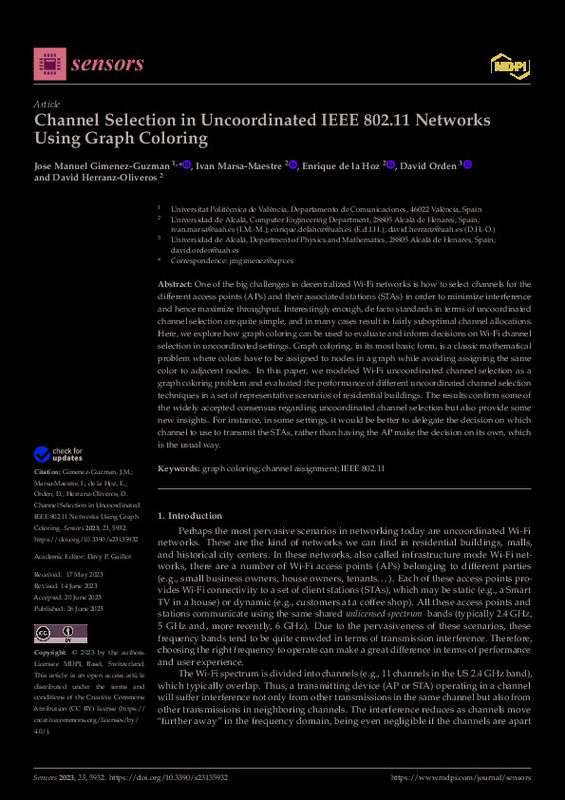JavaScript is disabled for your browser. Some features of this site may not work without it.
Buscar en RiuNet
Listar
Mi cuenta
Estadísticas
Ayuda RiuNet
Admin. UPV
Channel Selection in Uncoordinated IEEE 802.11 Networks Using Graph Coloring
Mostrar el registro sencillo del ítem
Ficheros en el ítem
| dc.contributor.author | Gimenez-Guzman, Jose Manuel
|
es_ES |
| dc.contributor.author | Marsá-Maestre, Iván
|
es_ES |
| dc.contributor.author | de la Hoz, Enrique
|
es_ES |
| dc.contributor.author | Orden, David
|
es_ES |
| dc.contributor.author | Herranz-Oliveros, David
|
es_ES |
| dc.date.accessioned | 2024-02-22T19:01:58Z | |
| dc.date.available | 2024-02-22T19:01:58Z | |
| dc.date.issued | 2023-07 | es_ES |
| dc.identifier.uri | http://hdl.handle.net/10251/202745 | |
| dc.description.abstract | [EN] One of the big challenges in decentralized Wi-Fi networks is how to select channels for the different access points (APs) and their associated stations (STAs) in order to minimize interference and hence maximize throughput. Interestingly enough, de facto standards in terms of uncoordinated channel selection are quite simple, and in many cases result in fairly suboptimal channel allocations. Here, we explore how graph coloring can be used to evaluate and inform decisions on Wi-Fi channel selection in uncoordinated settings. Graph coloring, in its most basic form, is a classic mathematical problem where colors have to be assigned to nodes in a graph while avoiding assigning the same color to adjacent nodes. In this paper, we modeled Wi-Fi uncoordinated channel selection as a graph coloring problem and evaluated the performance of different uncoordinated channel selection techniques in a set of representative scenarios of residential buildings. The results confirm some of the widely accepted consensus regarding uncoordinated channel selection but also provide some new insights. For instance, in some settings, it would be better to delegate the decision on which channel to use to transmit the STAs, rather than having the AP make the decision on its own, which is the usual way. | es_ES |
| dc.description.sponsorship | This publication is part of Project TED2021-131387B-I00 funded by MCIN/AEI/10.13039/501100011033 and by the European Union "NextGenerationEU"/PRTR and of Project PID2021-123168NB-I00 funded by MCIN/AEI/10.13039/501100011033/FEDER, UE. Ivan Marsa-Maestre and David Orden are partially funded by Project SB-PLY/19/180501/000171 of the Junta de Comunidades de Castilla-La Mancha and FEDER and by Project WiDAI (CM/JIN/2021-004) of the Comunidad de Madrid and University of Alcala. Jose Manuel Gimenez-Guzman, Ivan Marsa-Maestre, and David Herranz-Oliveros are also funded by Project PID2019-104855RB-I00/AEI/10.13039/501100011033 of the Spanish Ministry of Science and Innovation. David Orden is also partially supported by Project PID2019-104129GB-I00/AEI/10.13039/501100011033 of the Spanish Ministry of Science and Innovation. The APC was funded by Project TED2021-131387B-I00 funded by MCIN/AEI/10.13039/501100011033 and by the European Union "NextGenerationEU"/PRTR. | es_ES |
| dc.language | Inglés | es_ES |
| dc.publisher | MDPI AG | es_ES |
| dc.relation.ispartof | Sensors | es_ES |
| dc.rights | Reconocimiento (by) | es_ES |
| dc.subject | Graph coloring | es_ES |
| dc.subject | Channel assignment | es_ES |
| dc.subject | IEEE 802,11 | es_ES |
| dc.subject.classification | INGENIERÍA TELEMÁTICA | es_ES |
| dc.title | Channel Selection in Uncoordinated IEEE 802.11 Networks Using Graph Coloring | es_ES |
| dc.type | Artículo | es_ES |
| dc.identifier.doi | 10.3390/s23135932 | es_ES |
| dc.relation.projectID | info:eu-repo/grantAgreement/AEI/Plan Estatal de Investigación Científica y Técnica y de Innovación 2017-2020/PID2019-104129GB-I00/ES/TEORIA Y APLICACIONES DE CONFIGURACIONES DE PUNTOS Y REDES/ | es_ES |
| dc.relation.projectID | info:eu-repo/grantAgreement/AEI/Plan Estatal de Investigación Científica y Técnica y de Innovación 2017-2020/PID2019-104855RB-I00/ES/PLATAFORMA DE RESILIENCIA BASADA EN CLOUD PARA INFRAESTRUCTURAS DE TI SANITARIAS/ | es_ES |
| dc.relation.projectID | info:eu-repo/grantAgreement/AEI/Plan Estatal de Investigación Científica y Técnica y de Innovación 2021-2023/PID2021-123168NB-I00/ES/EVOLUCION DE LA RED DE ACCESO RADIO HACIA 6G PARA SERVICIOS MASIVOS Y DE BAJA LATENCIA/ | es_ES |
| dc.relation.projectID | info:eu-repo/grantAgreement/AEI//TED2021-131387B-I00//REDES VERDES: HACIA REDES 6G RESPETUOSAS CON EL MEDIO AMBIENTE/ | es_ES |
| dc.relation.projectID | info:eu-repo/grantAgreement/CAM//CM%2FJIN%2F2021-004/ | es_ES |
| dc.relation.projectID | info:eu-repo/grantAgreement/JCCM//SBPLY%2F19%2F180501%2F000171/ | es_ES |
| dc.rights.accessRights | Abierto | es_ES |
| dc.contributor.affiliation | Universitat Politècnica de València. Escuela Técnica Superior de Ingenieros de Telecomunicación - Escola Tècnica Superior d'Enginyers de Telecomunicació | es_ES |
| dc.description.bibliographicCitation | Gimenez-Guzman, JM.; Marsá-Maestre, I.; De La Hoz, E.; Orden, D.; Herranz-Oliveros, D. (2023). Channel Selection in Uncoordinated IEEE 802.11 Networks Using Graph Coloring. Sensors. 23(13). https://doi.org/10.3390/s23135932 | es_ES |
| dc.description.accrualMethod | S | es_ES |
| dc.relation.publisherversion | https://doi.org/10.3390/s23135932 | es_ES |
| dc.type.version | info:eu-repo/semantics/publishedVersion | es_ES |
| dc.description.volume | 23 | es_ES |
| dc.description.issue | 13 | es_ES |
| dc.identifier.eissn | 1424-8220 | es_ES |
| dc.identifier.pmid | 37447781 | es_ES |
| dc.identifier.pmcid | PMC10347276 | es_ES |
| dc.relation.pasarela | S\498285 | es_ES |
| dc.contributor.funder | Comunidad de Madrid | es_ES |
| dc.contributor.funder | Agencia Estatal de Investigación | es_ES |
| dc.contributor.funder | European Regional Development Fund | es_ES |
| dc.contributor.funder | Ministerio de Ciencia e Innovación | es_ES |
| dc.contributor.funder | Junta de Comunidades de Castilla-La Mancha | es_ES |








